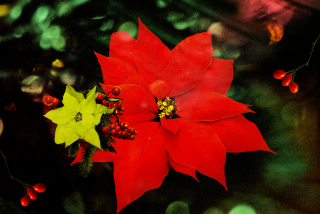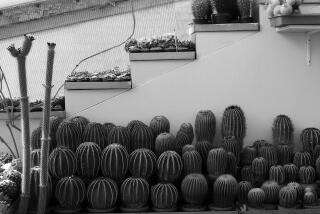Poinsettias Are More Than Decorative--They Have Commercial Potential
They coined a term in Mexico for Joel R. Poinsett’s bad attitude-- poinsettismo , which means officious and intrusive.
As the first U.S. minister to Mexico in 1825, Poinsett was deeply involved in the country’s politics and a meddler in the affairs of many other Latin American nations. He was finally declared persona non grata in 1829 by the exasperated Mexican government.
The statesman and amateur botanist from South Carolina, however, managed to salvage his name for history. He brought into cultivation from Mexico a plant Mexicans today call flor de noche buena , flower of the blessed night. People in the United States instantly recognize this deep green and brilliant red plant as the poinsettia, a perennial favorite for cheerful holiday decorations.
This year, as in many years since Poinsett discovered the plant near Mexico City, florists and proprietors of commercial greenhouses will no doubt feel merrier by the moment as they ring up millions of dollars in poinsettia sales.
But the poinsettia is just one species in a large and fascinating family of plants, the Euphorbiaceae . These plants keep on giving throughout the year.
Botanists have now set out to better understand these plants. Some have commercial potential, especially as a source of pharmaceutical compounds. A few species might even provide a cleaner, renewable substitute for gasoline and other fossil fuels.
The Euphorbiaceae (pronounced yoo-FOR-beeAY-see), or spurge family, is a large group of flowering plants, composed of approximately 3,000 species. Species of economic value include the Brazilian rubber tree, a source of natural rubber, and cassava, also known as manioc and tapioca, used as a foodstuff.
Plant enthusiasts will quickly recognize cultivated species, such as the beautiful “crown of thorns” from Madagascar, so named for its abundant sharp spines and the small, blood-red parts of its flowers. “Snow-on-the-mountain,” one of dozens of species native to the United States, has green leaves bordered in white. Ornamentals include crotons, known for their colorful foliage. Some succulent species, most from Africa or Asia, can be difficult to distinguish from cacti, which are unrelated.
Within this family, the poinsettia is further classified into the genus Euphorbia . “The genus as a whole is cosmopolitan,” says Dr. Robert Faden, a botanist at the Smithsonian Institution’s National Museum of Natural History in Washington, D.C. By that, he means Euphorbia , some 1,600 to 2,000 species in all, are found all over the world. In appearance, they range from spectacular trees that grow nearly 100 feet tall in East Africa to small lawn weeds in North America.
“The most interesting thing about this genus, from the botanical point of view,” Faden says, “are their flowers.” The poinsettia provides a good example: Many people mistake its bright red structures for petals.
In fact, Faden says, these parts of the plant are known as bracts, which are modified leaves. Like true petals, they attract the attention of people--and insects. The poinsettia’ s true flowers are found at the ends of stems bearing the colorful bracts. The minute, simple flowers are held in a yellow-green cup-shaped structure called a cyatheum. Each flower-like cyatheum contains numerous male flowers and a single female flower.
“In terms of evolution,” Faden says, “the flowers may have lost parts, such as petals, when they switched from insect to wind pollination. For some reason, that reproductive strategy didn’t work. To switch back to insect pollination required the ability to attract insects again. But because the flowers could no longer produce petals, the plant had to develop new structures--the cyatheum and colored bracts.”
Evolution also played a hand in the similarity between succulent species of Euphorbia and species of cactus. A theory known as “convergent evolution” holds that the similarities in appearance between cactus and some Euphorbia result from the plants’ development in similar arid environments.
Discerning succulent Euphorbia from cactus, however, is not difficult. The Euphorbia , Faden explains, almost always have paired spines. Cactus, on the other hand, have spines that appear in clusters, the largest being the most visible.
But the real giveaway for Euphorbia is the milky sap of the plants. Break off a spine on a succulent Euphorbia and the white fluid almost immediately oozes out. But watch out, the latex is often highly caustic, which, along with the spines, provides protection in the wild against predators.
Faden, who is an expert on African botany, remembers a good example of the potency of this latex. In Kenya, he lived in a house with a hedge formed by Euphorbia tirucalli , the so-called pencil shrub because of its long, pencil-shaped arms. When he tried to hire someone to cut the hedge back, no one was willing. People in Kenya, he says, have a healthy respect for the plant’s toxic sap, which can cause temporary blindness if it gets in a person’s eyes.
This same characteristic, however, makes many succulent Euphorbia interesting to scientists who search for plant compounds chemically active against a variety of diseases, including AIDS. One plant in the family, Ricinus communis , is the source of the cathartic agent castor oil. Unfortunately, Faden says, most of these species occur in the tropics where rapid deforestation and other environmental destruction threaten their existence.
Botanists who study the Euphorbiaceae family know its reputation for being difficult to classify species properly. Many researchers have chosen simpler families to study instead, says Dr. Michael J. Huft, a botanist with the Missouri Botanical Garden in St. Louis. As a result, some plants in the Euphorbiaceae family have not been studied since the 19th Century, he says.
To help turn that situation around, Huft recently organized a conference on the Euphorbiaceae at the Missouri Botanical Garden. The result, he says, should be better coordination and communication between botanists who study this family.
Huft organized the conference with Dr. Grady Webster, a botanist at UC Davis. One of Webster’s interests has been the potential for some plants in the Euphorbiaceae family as a renewable substitute for fossil fuels, such as gasoline. “The genus Euphorbia is probably the most promising,” he says.
The sap of many of these plants, he continues, contains hydrocarbons, the basic chemical component of fossil fuels. Some Euphorbia species in Africa, in fact, are known as “gasoline trees;” many people believe incorrectly that their sap can be directly used for fuel. The sap usually contains rubber, however, which must be removed before the sap can be further refined into such fuels as methanol and ethanol.
The current price of fossil fuels in the United States, Webster notes, does not provide much incentive for switching to Euphorbia fuels. Nonetheless, it’s absolutely inevitable, he says, that the U.S. automobile industry will have to switch to cars that burn cleaner fuels, such as methanol and ethanol.
Pollution such as low-lying ozone and smog comes from automobile exhaust. “I don’t see any other solution than going to methanol,” Webster says. In Brazil, he notes, automobiles already run on a mixture of gasoline and ethanol or methanol derived from plant material.
The potential of such plants in the Euphorbiaceae family could not have been imagined by Joel Poinsett, who went on to help found the National Institute for the Promotion of Science and Useful Arts, a precursor of the Smithsonian Institution. But his eye for natural beauty has left us poinsettias that doubtless will brighten holidays for many decades to come.
More to Read
Sign up for Essential California
The most important California stories and recommendations in your inbox every morning.
You may occasionally receive promotional content from the Los Angeles Times.










